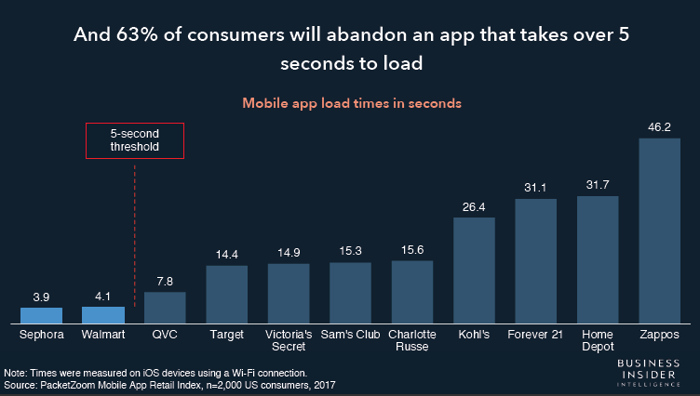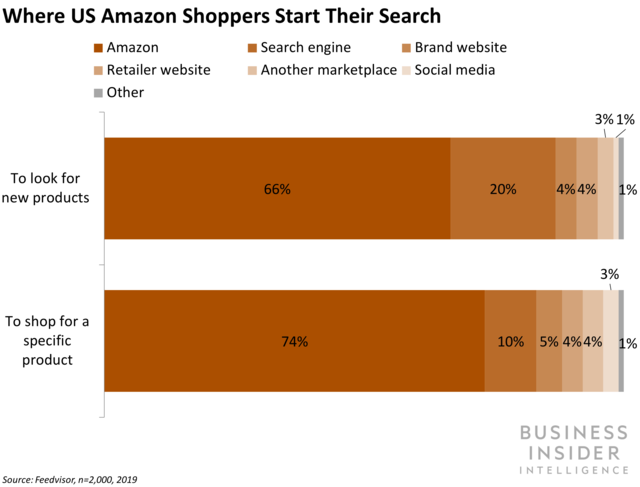
What are key factors that determine eCommerce success? Here's a look at 3 for February of 2019.
Page Load Speed is a Key to Mobile eCommerce Success
Total eCommerce retail sales in the United States grew from 9.1% in Q4 2017 to 9.9% in Q4 2018. Growth in sales from mobile devices passed 40% in Q4 of 2019 in the U.S., overtaking desktop for the first time. The number one reason shoppers drop out off a mobile eCommerce site is slow web page load speed. Google found 53% of mobile website visitors will leave a mobile webpage if it does not load within 3 seconds. In the same study, sites loading within at least 5 seconds had 70% longer visitor sessions. How fast are your mobile eCommerce web pages loading? To learn how fast your mobile speed is, Google has created this tool from which you can quickly find out. Just go here.

Perhaps more startling is the difference a second makes in eCommerce. According to research by Shopify:
- If a site makes $100K per day, a one second improvement generates an additional $7K daily
- A one second delay in load time normally equals an 11% loss in pageviews
- A one second delay also means an overall 7% drop in conversions
If you are not investing now in improving your mobile UX experience, you are already behind. Why, because it pays off. Pier One decreased its mobile home page load times and saw a 107% increase in mobile revenue per visit over the three months after the redesign and a 93% jump in its smartphone conversion rate (Internet Retailer, 2017.
Where are US Amazon Shoppers Starting Their Search?

Online shoppers are relying heavily on Amazon throughout the shopping process, according to a report from Feedvisor. When respondents check prices before making a purchase, 82% use Amazon, and 79% use the e-tailer to check reviews before buying, according to the poll of 2,000 US shoppers who've bought a product on Amazon in the last two years.
Moreover, when these consumers begin a search for a new product, 66% start on Amazon, and if they have a specific product in mind that they want to buy, the portion going to Amazon grows to 74%. Are you showing up in Amazon searches?
Amazon has its own ranking algorithm called A9. You can check here for their official statement on how they calculate search results. Before a customer ever begins a search on Amazon, the A9 team has been:
- Analyzing billion of data points
- Cataloging and interpreting past traffic patterns
- Indexing the text of describing every product in their catalog
Using their algorithm, they determine which items are the most relevant matches to the query. Amazon define's relevance by putting themselves in the eye of the customer. They are continuously evaluating their A9 algorithm using human insights and judgments, programmatic analysis, performance metrics, and key business metrics. Here is one way to compare the approach of Amazon to Google.
- Google says, “What results most accurately answer the searcher’s query?”
- Amazon says, “What products are the searcher most likely to buy?”
Based on researching the A9 algorithm, what you need to know about what influences it, are these primary factors.
- Conversion Rate - which is affected by pricing, customer reviews, their image requirements and such.
- Customer Satisfaction - which is composed of a series of sub-factors to create a customer retention ranking.
- Relevancy - see above.
Here are two additional resources for you to use in pouring over the entire list of factors Amazon considers in its developing product rankings for presentation in searches. Additionally, brands have found it beneficial to advertise on Amazon as a means to get more eyeballs on their products during searches.
Customer Reward Programs - What's Working
In a recent detailed report by the DMA, Customer Engagement 2018: How to win trust and loyalty, nearly half of US online 18-35 year-olds say that these points-based programmes do influence what they buy and how much they spend. However, notably less (only 41%) say these schemes make them feel more loyal to the brand. The DMA’s latest report reveals that these points schemes are:
"still, on the whole, well received. Although, these programmes are also one of the only areas where prevalence is higher than the number of consumers who like or would like to receive from brands (just 77%), suggesting these schemes may be hitting a saturation point."
As with everything in digital eCommerce, change is afoot and brands need to look beyond traditional models of reward to get consumers engaged. As Forrester’s report agrees:
“If you want to build a loyalty programme that isn’t just a replication of every other programme out in the marketplace, you have to start with your customers. Specifically, you must deepen your understanding of what they expect from programmes, how they feel about the benefits, and how they interact with them.”
Some 77% of consumers say they like being given points to use. Consumers are also enthusiastic about a range of benefits including priority access to sales (57%), exclusive member discounts (67%), and free gifts (71%). REI, North Face, and Moosejaw all have highly successful customer reward programs. Here are some other examples of outstanding customer reward programs.
All of these programs have four essential ingredients. They are:
- Outstanding Rewards
- Emotional Connection
- Digital Optimization
- Rewards Provided Beyond Just Transactions
Reward programs build long-term loyalty and customer satisfaction on a regular basis. Besides the DMA study, you can read the full Forester Report on The Psychology of Points.
If you are interested in learning more about successful eCommerce strategies, check this out.



